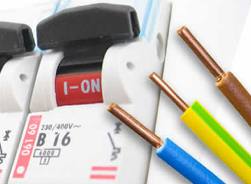Categories: Featured Articles » Electrician at home
Number of views: 18700
Comments on the article: 7
Proper operation of electrical equipment and wiring in a country house
 All rules related to the safety of operation of domestic electrical equipment are of particular importance in relation to a country house due to its isolation. There is no operating organization, and the state of the electrical economy remains entirely the responsibility of the homeowner.
All rules related to the safety of operation of domestic electrical equipment are of particular importance in relation to a country house due to its isolation. There is no operating organization, and the state of the electrical economy remains entirely the responsibility of the homeowner.
It turns out that in theory, the homeowner should have knowledge of electrical engineering at the level of the person responsible for the electrical industry, which corresponds to the fifth tolerance group for electrical safety. In practice, this, of course, is rarely achievable. However, everyone can remember and learn some rules. We’ll talk about them.
1. Changes in the wiring diagram and the composition of the home electrical panel should be made only after consultation with specialists. Additional sockets, stationary power consumers, entire newly attached rooms with their own lighting circuits - all this is an additional load on the electrical network. And, although any electrician during installation and design provides a certain reserve for power, it is far from the fact that in your case this reserve will be enough.
2. When using shields with a large number of modules and having a wide variety of equipment, there are cases when the contacts of any device are arbitrarily bridged due to constant and annoying trips. This is a direct way to serious troubles: fire or electric shock. The reasons for the operation of the protection devices should be carefully understood, and if their own qualifications are not enough, attract specialists for this. The same can be said about the arbitrary replacement of devices with similar ones having a different nominal value.
3. The power of electrical appliances plugged into sockets must match their current rating. Of course, appliances with factory plugs will not be able to overload 16 amp sockets, unless you use an extension cord and string the entire “kitchen arsenal” onto one socket. Therefore, it is better to bring all the outlets in the house to a single, “16-amp denominator”, so that you can think less about the correspondence of the load later. When replacing plugs on devices with a power of more than 3.5 kW, use only special power connectors.
4. Devices, protection devices, plug connectors, plugs, wires and cords that show clear signs of a malfunction are subject to mandatory and immediate decommissioning. Signs of malfunction include: sparking, unusual loud noise during operation (hum), excessive heat (up to the body melting or external insulation), external damage (chips, cracks, breaks, cuts).
5. Do not overly get involved in extension cords and splitters. The point here is not only the possibility of overloading the socket by connecting too many devices to it. An excess of wires thrown along the floor along the walls can lead to some of them almost inevitably being under your feet, under the legs of heavy furniture, in the teeth of rodents or pets, in the playful hands of your young children. All of the above does not bode well. Therefore, unnecessary open wires in a country house must be disposed of.
6. The need for constant supervision of operating electric heaters is a common truth, however, many homeowners still do not attach due importance to it.
7. Household appliances located in the bathroom, as in a room with an increased risk of electric shock, should only be connected to a circuit that is protected against leakage currents.If there is no RCD or differential circuit breaker in the switchboard, then at least installation of a socket in the bathroom, which is structurally combined with an RCD, is necessary.
8. The repeated grounding device at the entrance to the country house is of particular importance. The conductors that make up this device must be systematically inspected for integrity, and it is advisable to check the memory resistance at least once a year - this is a safety issue.
Other articles from this series:
Power supply of a country house
The composition of the home electrical panel
Grounding device for a country house
Internal wiring of a country house
Installation of electrical wiring in a country house
Wiring accessories and devices for a country house
Autonomous sources of electricity for a country house
Correct connection of powerful power consumers
Alexander Molokov
See also at e.imadeself.com
:
